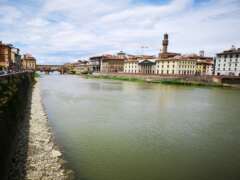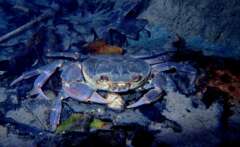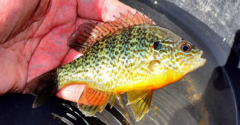Only One Native Fish Species In The River
Over the past 215 years, the Arno’s aquatic fauna has undergone fundamental changes.
Together with researchers from Italy, Senckenberg scientists examined the ecosystem of the Arno river in Florence over a period of 215 years. They arrived at the conclusion that the fish species originally native to Italy have been replaced almost entirely by non-native species. And the snails, bivalves, and crustaceans now also comprise 70 percent of invasive species. In their study, recently published in the scientific journal “Global Change Biology,” the researchers show that this changeover in the ecosystem was caused by humans.
At 241 kilometers, the Arno is the second-longest river in Central Italy. It meanders through northern Tuscany, eventually flowing into the Tyrrhenian Sea at Marina di Pisa. “The Arno’s development and its fauna and flora are closely linked to the history of the Tuscan capital and the Florence region,” says Dr. Phillip J. Haubrock of the Department of Stream Ecology and Nature Conservation Research at the Senckenberg Research Institute and Natural History Museum in Frankfurt.
Together with Senckenberg’s Prof. Dr. Peter Haase and other colleagues, Haubrock studied the development of the ecosystem in the Arno over a period of 215 years. In the process, in addition to their own surveys, the German-Italian team analyzed numerous historical documents and collections and interviewed local historians as well as amateurs and experts with an interest in natural history. “We were particularly interested to learn how the species composition and diversity in the river changed over time – and which factors were responsible for these changes,” adds Haubrock.
The results of the long-term study are extreme: Around 1800, the fish inventory still comprised 92 percent of native species; a little over 200 years later, only six percent of the originally native species survived – the remaining fauna in the Arno is now composed of invasive, non-native fishes. A similar changeover from native to invasive species can also be found among macro-invertebrates such as bivalves, snails, and crustaceans: Only 30 percent of these organisms in the river can currently still be considered native. “We can state that an almost complete changeover from native to invasive river dwellers has occurred in the Arno – among the fishes, the tench (Tinca tinca) is the only remaining species originally native to Italy,” explains the scientist from Gelnhausen.
The fauna changeover in the studied groups of animals has various effects on the so-called “alpha diversity” – the measure for the entire species diversity in a biome. Haubrock explains, “If you look at the entire time period, the species diversity among the fishes increases due to the invasive species, while the species numbers among the macro-invertebrates generally show a decline – here, the invasive species were unable to compensate for the loss of native animals.”
But what caused the fauna changeover in the Italian river in the first place? According to the study, the introduction of foreign fish species can be traced back to the economic growth of the Florence region between 1900 and 1950. During this time, both the demand for food sources and for recreational activities increased. “We were able to show that during this time, numerous angling associations were founded, and the citizens of Florence intensified their fishing activities – for this purpose, even non-native species were deliberately released in the river,” explains Haubrock. Moreover, the urban growth also had an impact on the river’s hydromorphology: The Arno was channeled and dredged, leading to an increase in currents and sediment transport – environmental changes the non-native animals were better able to cope with.
“Human activity – both the deliberate and the accidental introduction of new species, changes in the river course, and the increasing environmental pollution – caused the replacement of native species by invasive animals,” adds working group leader Haase, and he cautions, “The Arno is no isolated case. In many rivers in Germany and Europe, the proportion of non-native species has noticeably increased in recent decades. We therefore need long-term studies with a unified recording system to be able to implement a successful and sustainable environmental management in this regard!”
Publication
Haubrock, P.J., Pilotto, F., Innocenti, G., Cianfanelli, S. and Haase, P. (2020), Two centuries for an almost complete community turnover from native to non‐native species in a riverine ecosystem. Glob Change Biol. Accepted Author Manuscript. https://doi.org/10.1111/gcb.15442


